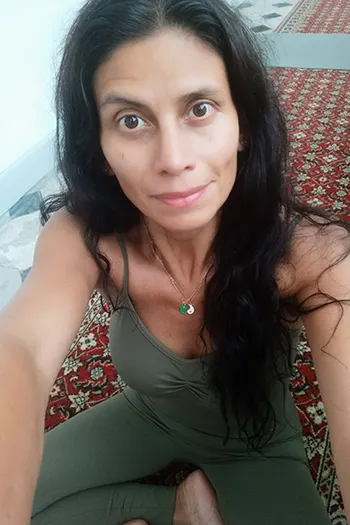asana as the arrow, and the soul the target.
-B.K.S Lyengar-
Hatha Yoga originated in Northern India more than 5000 years ago and was taught as a healing system for the mind and to prepare the body for seated meditation.
Today Hatha yoga focuses on posture and breathing techniques, traditionally to channel vital energy source. In Sanskrit, Hatha translates to force. The practice involves breath, body, and mind.
Welcome to Hatha Yoga. Hatha yoga uses physical poses to generate strength and flexibility and to drive energy into all areas of the body, removing any built-up tension.
The sole purpose of Hatha yoga is to awaken the Kundalini energy and to bring the body into a state of Samadhi, a deep state of meditative consciousness.
The word “Hatha” is a combination of two different energy components. It derives from the Sanskrit words: HA – Meaning “sun” and represents action & heat. This masculine energy is found in the Pingala Nadi, which is situated in the right hand side of the body and interacts with the left hand side of the brain.
THA – Meaning Moon and represents cool & stillness. This feminine energy is found in the Ida Nadi, which is situated in the left hand side of the body and interacts with the right hemisphere of the brain.
This union between the sun and the moon creates a feeling of balance and harmony within the body and mind connection of our being.


Hello my name is Isabel
Through Hatha Yoga I can help you to reconnect within yourself, increasing your energy, calming your mind and balance your energy in all your body.
In the Hatha Yoga tradition, the focus is on the postures and finding an alignment within them that can bring us to a state of steadiness. This is known as sukha and shtira, the balance between effort and ease.
In my classes we start with Savasana, a resting posture, then with Pranayamas that is a breathwork, passing to Sun salutation and then Asanas that are postures that allow participants the opportunity to explore how their body feels, as well as to create space for modifications and adaptations. We also focus on allowing the breath to be an anchor to the present moment, enabling us to observe our inner landscape. Finishing with Savasana a gentle and relaxing posture that allows your body and mind time to rejuvenate and absorb all that good work you have done for your body.
My teaching style allows time for slow, mindful transitions between asanas (postures). This makes the practice more accessible for beginners as well as those who like to take a bit more time in postures, refining their physical or energetic alignment.
My Story
As a RTT Rapid Transformational Therapist, Mindfulness teacher, Facial Emotional Therapist and Hatha Yoga teacher I realized that many of my clients experienced not only emotional illnesses but also physical illnesses. Some of them they were not aware of their bodies at all and they didn’t realize how their emotional and physical state relate to each other.
This is what is called Parity of Esteem . The need to value mental health equally with physical health. These two are often linked. People with poor physical health are at higher risk of experiencing poor mental health, and people with poor mental health are more likely to have poor physical health. All are related.
With Mindfulness I noticed that many of the clients when they had to do a physical posture and breath at the same time, they discovered that they were able to relax their minds and bodies. Adding Hatha Yoga definitely provides a calm space for the individual to be purely present, focusing with their own body sensations, limitations and challenges that requires each posture, creating a space without any judgment of themselves and at the same time activating their energy in all the body bringing balance and harmony within themselves.
The body is your temple.
Keep it pure and clean for the soul to reside in
– B.K.S Iyengar –
Member Of




Frequently Asked Questions
The purpose of the practice is to create complete health of your mind and body and to allow breath and energy to flow through you freely.
Hatha yoga uses physical poses to generate strength and flexibility and to drive energy into all areas of the body, removing any built up tension.
The benefits include:
- Increase in flexibility– This may seem like an obvious benefit of yoga but being flexible is so important to our physical health. Flexibility allows you to use the maximum strength of your muscles, decreases risk of injury and lubricates your joints.
Flexibility is built up by holding postures that force us to stretch and twist muscles that we otherwise wouldn’t reach in our day to day activities.
- Lowers stress levels– This benefit you may notice immediately after your first class. The way breath is used during your practice stimulates the parasympathetic nervous system, our rest and digest state. This enables us to still the busy mind and lower the heart rate.
One study taken by UCLA revealed a reduction in the proteins responsible for increased inflammation which trigger stress in the body.
- Strengthens and tones the body– Working with your own body weight is an excellent way of building strength and tone in the body, and this is exactly what you do in a Hatha yoga class. A lot of the poses taught will be held for longer periods of time, will engage your muscles and be repeated throughout the class.
- Increase in fitness– In a study looking at the physiological changes in adult women after a short period of regular yoga practice, evidence showed an increase in cardiorespiratory efficiency.
- Boosts your immune system – Twisting and stretching your body stimulates your lymphatic system and increases the drainage of toxins in the body. This helps the body to fight infection and illness and improve overall health.
- Mood Elevation – Many studies have been performed to show how beneficial yoga and meditation can be on our mental health. The Harvard Medical School recognizes the positive effect yoga has on reducing anxiety and depression.
A Hatha yoga class will usually last for 75 – 90 minutes and in this time you would be guided through the following techniques.
Pranayama – Pranayama consists of controlled breathing techniques that have a direct impact on your nervous system and life force energy in the body. You would be introduced to deep breathing techniques and possibly some breathing exercises to either stimulate your mind and body or relax it, depending on the nature or the time of the class.
Pranayama translates to ‘life force extension’. Prana meaning life force or breath, and ayama meaning to extend. The practice of pranayama is said to extend the life within us and awaken our Kundalini energy.
Sun Salutation – Many Hatha classes will use sun salutations to warm up the body and build up heat within.A sun salutation is a flow of yoga asanas linked together with breath. They are extremely energising and combining your inhale and exhale with each transition creates a moving meditation, encouraging stillness and focus in the mind.
Asana – As we have learned that Hatha represents the physical side of yoga it should be no surprise that a large chunk of the class will be dedicated to the practice of yoga postures.
You will be guided through standing postures, core work, balancing postures, back bends, inversions and poses on the floor. The structure of the class will be put together in a systematic way to allow you to get the most out of each pose.
Savasana – Or corpse pose in english, is a favourite for many. This final pose requires you to lay on your back with your arms and legs apart, like a starfish, and to let go completely.
Savasana is an essential part of the yoga class and allows your body and mind time to rejuvenate and absorb all that good work you have done for your body.
You would generally lay here for 10 – 15 minutes with your eyes closed and your body heavy on the floor. Breathing deeply in savasana allows you to release tension in the body and to wake up feeling energized and nourished.
With 12 sessions of regular Hatha yoga practice can significantly decrease levels of anxiety and depression. 4 weeks (3 time/weeks; 60-70 min each) can have a big impact in your life.
You can also take from one session to 16 sessions . Is open to any anyone who wants to increase flexibility, strengthen, tone the body, mood elevation and increase energy in a holistic way.
The mind is the king of the senses, but the breath is the king of the mind.
– Hatha Yoga Pradipika
Benefits of working with Isabel

I can provide you all the needed support during your process, offering you the following.
One session to five sessions
One session to ten sessions
One session to twelve sessions
One session to sixteen sessions
Address: Trondheimsvej 56 , 8600 • Silkeborg • Denmark.
If you want to know more about...
Company registered in Denmark CVR 43335294
